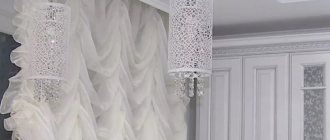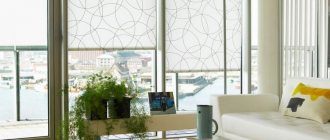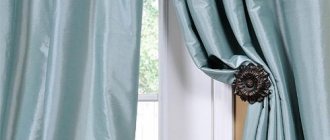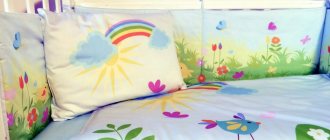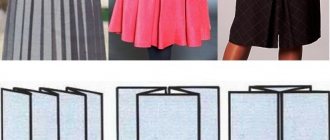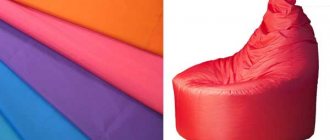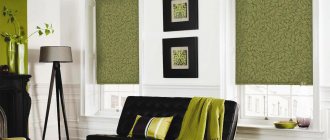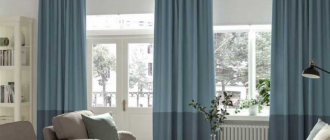Before answering the question of what types of curtains there are, let’s first consider the main elements that make up window curtains. The curtain can be either simple, consisting of one sheet, or containing a set of decorative elements. It is these elements that set the style of the curtain, which in turn sets the style of window design and affects the design of the room as a whole.
The names of the component parts - elements of curtains - will appear later when describing the types of curtains. Therefore, you need to have an idea about them. So look at the picture:
Basic elements in curtains
Lambrequin - placed at the top of the window design composition and located parallel to the floor or ceiling. The texture of lambrequins can be either straight or with folds. There can be many folds or one in the center of the lambrequin. Single folds can be rectangular, triangular or conical. You can hang the lambrequin either by the cornice or directly on the curtain fabric. The lambrequin can also be stretched over a frame made of metal, wood or plastic. This frame is fixed to the cornice. The main function of lambrequins is decorative; they complete the composition and make the curtains look more balanced and complete.
Drapes are the main element in curtains. Curtains are made from dense, usually opaque fabrics. Curtains can have double-sided decoration on both the front and back of the fabric. The back part can be a contrasting color in relation to the face of the curtain, or contain a pattern different from the front one. The main function of curtains is to protect the room - during the day from bright light from the windows, and in the evening from prying eyes from the street.
Tiebacks are usually paired elements located along the side edges of the curtain. Designed to fix curtains when open. They can also be used for draping - folding curtains and drapes. There are also single pickups. They fix the curtain to one edge.
Curtains - can be used as an additional element in the window composition or independently. Curtains are made from light transparent or translucent fabric. Since curtains allow daylight to pass through well, there is no need to open them during the daytime. Curtains closed during the day will protect the room well from onlookers outside the window. And in the evening, curtains will take on this role.
That's probably all there is to the basic elements.
And one more important point. When choosing the type of curtains, do not forget that for different curtains you will also need curtain rods corresponding to the curtains. I described in detail what kind of cornices there are in this article. Now let's figure out what types of curtains there are.
Curtains, according to the type of opening, can be divided into three main types:
- sliding,
- lifting
- stationary
Types of sliding curtains
The sliding type of curtains involves opening the curtains to the sides of the window. As a rule, the upper part of such curtains is fixed vertically to the cornice. Sliding curtains can be adjusted in width and height.
Classic straight curtains
This type of curtains is the most widespread. Classic straight curtains consist of thick curtains and light curtains mounted vertically on a cornice. Lined curtains can be used.
Crossed curtains
The panels of this type of curtains are fixed on opposite sides of the cornice. The fabric of the curtains goes cross to cross. Such curtains can consist of either two halves or one sheet that is thrown over the cornice.
Cafe curtains
This type of curtain refers to short curtains, the length of which does not fall below the top edge of the window sill. Cafe curtains are attached to a cornice or bar located in the middle of the window. The fabric can be either dense or transparent. In addition, various decorative elements can be used - buttons, loops, eyelets, etc. The height of the cafe curtains allows light to enter the window even when closed.
Curtains with lambrequins
From the name it is clear that this type of curtains is complemented by decorative elements - lambrequins. Lambrequins can be attached directly to the curtain fabric or have independent fastening elements. Lambrequins can have both a hard and soft design. Wooden slats can be used as the basis for a rigid structure, or braid for a soft one. For curtains with lambrequins, it is optimal to use a rail curtain rod, consisting of several rows for fastening the curtains. This type of curtains is used in classic interiors.
Japanese curtains
This type of curtains has a rigid structure. The curtains are fixed to the frame. Usually the width of one canvas does not exceed 1 meter. Japanese curtains are not adjustable in height, but move along the width of the window. Such curtains are very similar to screens, which are used as light partitions in a room. The use of Japanese curtains is appropriate in Japanese-style and minimalist interiors
Thread curtains (muslin)
This type of curtain is made of heavy silky threads. Due to the weight, the threads do not get tangled. Thread curtains can also be used to decorate doors or zoning space in the interior
Photo curtains
This is a fairly new type of curtain for the Russian market. For their manufacture, dense light-proof fabrics are used, for example, blackout or satinette. For those who like to sleep in the morning, these curtains will be a good surprise. The design is applied to the fabric using digital printing. Therefore, to order, you can make almost any design you like on your curtains. In addition, manufacturers make bed linen and tablecloths with photo-printed designs, which makes it possible to tie together the composition in the interior. The curtains open to the sides like regular straight curtains.
Types of lifting curtains
The next type of curtains combines the method of opening them. Lifting curtains open upward using special mechanisms. Lifting curtains are not adjustable in width; they have a fixed size, usually equal to the width of the window opening. Lifting curtains are also called flat, apparently because when opened, the curtain canvas moves along the plane of the window.
Austrian curtains
This type belongs to flat curtains. When raised, Austrian curtains form elegant wave-like folds. When lowered, the curtains hang straight and are slightly gathered at the bottom.
French curtains
This look is very similar to Austrian curtains. The main difference between French curtains is that they have small horizontal folds both when raised and lowered. These curtains are usually made of lightweight fabric. French curtains are adjustable only in height
Roman curtains
This type of curtains is also classified as flat curtains. They are made of thick fabric. Horizontally at equal distances, the fabric is stitched across the entire width and forms narrow horizontal pockets into which special strips are inserted.
The upper part of the Roman blind is firmly fixed to a special cornice, which is equipped with a lifting mechanism.
Roman blinds are raised using cords that are threaded into rings on the back of the curtain. When raised, the curtain forms horizontal folds.
Roman blinds are usually used in simple interiors or in the kitchen.
Some types of Roman blinds
English curtains
This type of curtain is a type of Roman blind. The main difference between English curtains and Roman curtains is their pomp. The pomp is created by the additional width of the fabric. When assembling the curtains, lush bow folds are formed.
Roller blinds
This type of curtain is a flat canvas that is assembled upward using a special mechanism. Using this mechanism, the curtain is rolled into a roll, which is hidden under the box at the top of the cornice. For lifting, a thread or chain is used, which can be either on the left or on the right side of the roller blind. The curtain lifting mechanism provides for fixing the curtain at different heights. The fabric for making roller blinds is usually quite dense. It can be either plain or with a pattern.
The advantage of roller blinds is their compactness. It does not protrude far from the window, and is often even in the frame. Such curtains will fit well into a minimalist interior.
Pleated curtains
This type of curtains came from Germany. They are often called pleated blinds. Indeed, pleated curtains look similar to horizontal blinds. But instead of the slats used in blinds, curtains use thick fabric with pleats. Pleated curtains can be used on windows with both simple and complex shapes. Fabrics for pleated curtains are treated with a protective compound that helps the fabric keep its shape and protects it from fading and dust. You can find pleated curtains made of paper.
Types of materials for curtains made of thick fabrics
To make curtains, dense fabrics that differ in texture and properties are used:
- velvet;
- jacquard;
- silk and satin (satin);
- linen and cotton.
Velvet fabrics have short pile on the front side. They are created from natural and artificial fibers. High-quality samples have thick pile that does not come out. Velvet materials are very diverse. They can have different reliefs on the surface: lines, patterns. Such options look rich. It is good to use them to decorate the hall. It is better not to make curtains for the kitchen from velvet fabrics.
Related article: How to decorate a mirror with your own hands
Corduroy samples are a type of velvet and have soft pile on the surface. They are made from cotton, synthetic and combined materials. Longitudinal scars are visible on the front surface of the corduroy. They can be of different widths: small, almost invisible or large, coarser. The surface of the fabric is matte. Corduroy curtains are beautiful and durable.
Jacquard is a dense material with a smooth surface. It is characterized by beautiful patterns that are obtained by interweaving fibers of various thicknesses. The threads can be multi-colored or dyed after creating the fiber. Jacquard curtains are quite durable and do not fade in the sun.
Brocade curtains are characterized by a relief pattern on the surface of the material. The design is embroidered with colored or shiny threads. Such fabrics are created from silk, cotton, wool and other raw materials. Sagging threads are visible on the reverse side of the fabric. Therefore, models made from these materials require lining. These curtains look good in living rooms.
Satin curtains are very smooth and have an attractive shine on the outside. The reverse surface is rougher and matte. The fabric is made from cotton, viscose, polyester and other fibers. The canvases can be single-color or with a printed pattern, decorated with embroidery. Satin curtains look elegant and festive. A great option for bedroom curtains. You can decorate curtains of this type with ruffles, ribbons, and other decorative elements.
Thick cotton and linen curtains are also used in the interior. Natural fabrics perfectly complement the interior. They look natural and create a calm, cozy atmosphere. Various synthetic fibers are added to them, which give the materials special properties. Coarse flax samples have good environmental properties. Less dust accumulates on them than on other types of curtains. The density of cotton fabrics may vary. Models with large weave of threads, characteristic of denim, look interesting. Cotton curtains come in various colors - both plain and with all kinds of prints. You can safely hang such curtains in the kitchen.
Related article: Ball valve: replacing an old product and installing a new one
Polyester curtain fabrics have proven themselves well. They are durable, soft, do not fade, and wash well. In addition, this artificial material perfectly retains its shape. It is suitable even for curtains of complex cut.
Types of stationary curtains
This type of curtains is united by the impossibility of their movement. The curtain fabric is fixed on the curtain rod and does not require the curtain to move along it. Typically, stationary curtains have a decorative function and serve to decorate the interior. For example, you can use them to create the illusion of a window in a windowless room.
Italian curtains
This type of curtain is a bit like crossed curtains. The peculiarity of Italian curtains is that the curtains are fixed to the cornice without the possibility of their movement from above. To open the curtains, they are simply pulled apart and tied with tiebacks. In this case, the tiebacks or cord for tying are located closer to the top of the curtain. This technique gives the window an interesting frame line and is a “trick” of Italian curtains. Italian curtains are well suited for non-standard windows. For example, arched ones. Sometimes, to pick up curtains, a simple mechanism consisting of rings and braid is used. The mechanism is attached to the back of the curtain.
Imperial curtains
Designers consider this type of curtain to be the most difficult to implement. Imperial curtains are pompous and ceremonial. They will look good in a large room with high ceilings.
Bishop sleeve curtains
Used to make the room look grand. They are made from both light and dense fabrics. To give curtains a more expressive volume, inserts made of tissue paper or padding polyester are sometimes used.
Stained glass curtains
Because of the similarity, this type of curtain is also called hourglass. The upper and lower parts of the curtain fabric are fixed on the cornice. In the center, the curtain fabric is collected using selection. The collection may take the form of a bow. This type of curtains is good to use on small windows in galleries or summer gardens. Hourglasses are also used to decorate doors with glass.
Purpose of curtains
In addition to decorative purposes, curtains made of thick fabrics can perform the following functions:
- prevent light from entering the room;
- reduce the noise level coming from the street;
- trap cold air;
- close the room from prying eyes.
Although a full life is impossible without light, there are times when it is not needed at all. In the summer, the sun begins to shine early in the morning and prevents you from getting a good night's sleep. Curtains will allow you to sleep longer. They are good as protection from the baking sun on a hot day. You just have to cover the window opening with them.
In winter, curtains made of thick fabrics prevent cold air from entering through the window. When the lights are turned on in the room, the room is clearly visible through the window on the street side. Thick curtains can solve this problem. They will protect the room from curious people. In addition, the materials from which curtains are made muffle sounds coming from the street. They also prevent cold air or sultry stuffiness from entering the room from the street.
Curtains for decoration
I have identified these curtains as a separate type because they do not serve to decorate windows, but to decorate other interior elements.
Curtains for doors and doorways
Curtains for doors can serve several functions
- decorative function - in this case, the curtains simply decorate the doorway and, depending on the style, can make your interior more formal or, conversely, more homely and cozy.
- the function of a partition or curtain between rooms or zones in a room. In this case, the curtain performs the function of a door - it closes the door frame and separates the rooms.
Door curtains can be attached to the cornice above the doorway or directly to the door. Attaching curtains to a door is usually used on doors with glass. An example of such fastening was presented above when describing stained glass curtains.
Canopy curtains
The word canopy comes from the Italian baldacchino, which meant “silk fabric from Baghdad.” The canopy appeared in the ancient East. Then an umbrella made of fabric was worn over the king, which protected him from the sun and prying eyes. Later, the umbrella turned into a portable throne or bed, protected by fabric around the perimeter. In rooms, the canopy was used as a curtain over a throne or a ceremonial seat. Later the canopy found itself in the bedroom. In Rus', our ancestors used a canopy to protect a baby's sleeping place from drafts and insects - hanging the fabric over the baby's cradle.
Currently, canopies are mainly used in bedrooms. The fabric is hung on special structures - or columns around the bed, as well as on a cornice attached to the ceiling above the bed. Canopy curtains will add comfort to your sleeping nest and, if necessary, protection from prying eyes.
Thick blackout curtains
One of the varieties of modern blackout curtains is made from special light-proof fabrics. These are the so-called blackout curtains. They perfectly darken a room, preventing light from any source from entering, be it the sun's rays, street lights, moonlight or an LED sign.
The fabrics for these curtains most often have a multi-layer structure. They are made from polyester fiber, the threads of which form a single or double satin weave. Blackout curtain material, in addition to excellent light-protective characteristics, has a number of valuable properties:
- dense structure;
- high strength;
- fire resistance;
- good thermal insulation;
- sound absorption;
- holds its shape well and allows you to create various draperies.
Such specimens are produced mainly by European manufacturers. The range is quite diverse; you can choose fabrics for different types of curtains. Fabrics can have different density and light transmittance. They differ in colors and patterns. Some samples may have special acrylic or polyvinyl chloride substrates with a metallized coating. The additional layer not only provides light resistance, but also prevents heat from entering the room on hot summer days. Such materials are often used to make roller blinds.
Softer fabrics with a three-layer structure are used for sewing classical and Roman curtains. Each layer of fabric is made using special technology. The middle layer provides light resistance. The front decorative layer is painted in various colors. A drawing can be applied on top. The layer on the reverse side is usually painted white.
Curtains made of thick blackout fabric can be used for various purposes. These curtains can be used to decorate the kitchen, living room, bedroom, and nursery. They are suitable for decorating office rooms and various public places. Lightproof curtains are good for roof windows, balconies and loggias. Due to its high quality and excellent functionality, this type of blackout curtains has become very popular.

